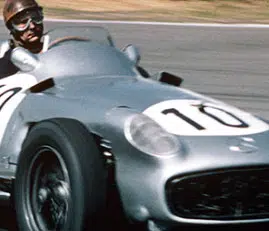One interesting point about the Nurburgring is its excellent concrete Paddock, with lock-up garages around the sides and the majority of teams take advantage of this, consequently there is always much of mechanical interest to be seen during the practice periods. Of the three works Ferraris, Ascari and Taruffi were using the new engines with the magnetos mounted in front of the cylinder block, while Farina had the earlier model with the magnetos in the scuttle. On the new engine a drive is taken from the nose of the crankshaft, through spur gears in a bolted-on aluminium casing on which the two four-cylinder magnetos are mounted. Originally the main fuel pump was driven from this point and with the modifications it has been moved to a higher position driven off the idler gear which drives the inlet camshaft. It seems that the magnetos in the old position under the scuttle ran too hot, even though cool air was ducted on to them. Fischer had his rear axle ratio changed on his four-cylinder Ferrari and at the same time attended to brakes, shock-absorbers and clutch, so that the car was stripped to the bare chassis frame at the back.
Another car that had its rear end exposed was Cantoni's Maserati A6G, not to change the ratio but to correct a nasty clicking noise. Like the Gordini, the Connaught and the Veritas, the Maserati has no chassis frame extending beyond the rear axle centre line, the fuel tank being over-hung and the oil tank bolted on to the back of it. Clearly the Formula II Maserati is a hybrid born of the old 4CLT and the 2-litre sports A6G, for the rear end is still hung on splayed ¼-elliptics and is a normal single piece axle, but with reduction gear from the prop.-shaft and an anti-roll bar behind the axle. Double-wishbones in conjunction with coil springs and an anti-roll bar look after the front, while the engine which is set to the near-side a little is a double overhead camshaft six-cylinder coupled to a 4CLT-type gearbox and the prop.-shaft runs at a slight angle to the centre line of the car. Cantotii and Bianco, on identical cars, formed the Escuderia Bandeirantes, representing Brazil, while Bonetto was driving the latest works car designated an A6GCM, which a wit suggested might mean "con motore." Outwardly this car was similar to the Brazilian car, with the exception of solid rubber blocks in the centre of the front suspension spring coils. Undoubtedly it was different inwardly as it was a lot faster and its crisper note indicated a higher compression and more exciting valve timing. It was interesting that this new six-cylinder contrived to make the same flat exhaust note as the old 4CLT when being pushed-started and before the revs, got up above 3,000 r.p.m.
Among the other private-owners of Italian cars the Belgian-owned four-cylinder Ferrari, a "production" model that only goes to 6,500 r.p.m., had a piece of inlet valve break off so that a first-rate view of the interior was to hand when it was dismantled. Impressive were the size of the rods, the slimness of the timing gears, the vast diameter of the inlet valves and the beautiful high-lift cams operating the hairpin-spring controlled valves through rollers and tappets. Ferrari's kindly lent one of their men to do the assembly.





